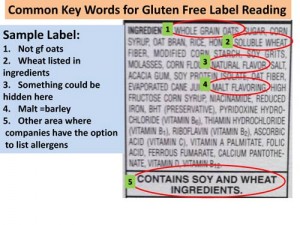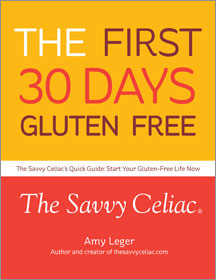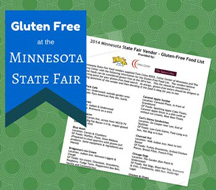It was telling. A single comment on a post I made about the Food and Drug Administration’s plan to get a proposed gluten-free labeling rule back on track.
Take a read… It may just take you back to when you discovered you had to go gluten-free.
“Four hours ago, I learned that lab reports indicate that I may have celiac disease. I’m very surprised to learn that labels do not indicate information regarding gluten. Previously, I did not attend to information about gluten. How am I to easily regulate my food intake without such information? I hope that the upper GI does not confirm the working diagnosis, for control seems unnecessarily difficult without appropriate labeling.” -Shirley
This is the kind of question someone who is new to the gluten-free world asks! This is why labeling is so important! It’s not only for us “regulars” who have learned how to navigate an ingredient list on a label. Gluten Free labeling benefits everyone: Newly diagnosed folks like Shirley, family members who want to make something gluten free but don’t know where to begin, and even for veterans to confirm what we know and put our minds at ease.
Reading labels for Gluten
In light of Shirley’s question, I thought I would make a quick list of things to know when reading labels.
For a cool visual aide, I found one–glutenty product in my cupboard that highlights several of the points below, took a picture of it and highlighted some of the things mentioned in the list. You can view it more closely by clicking on the image, or download the PDF now.
- Familiarize yourself with the ingredients that are safe for celiacs and not safe for celiacs. The lists linked here are from a reliable resource: celiac.com. By doing this you will be able to get through a grocery store more quickly than oh say 3 hours. Seriously, it will take time to read ingredients, please plan on it so you don’t feel rushed.
- Understand the Food Allergen Labeling and Consumer Protection Act, which says food manufacturers are required to reveal when they have any of the top allergens in their food. Wheat is a top allergen– Gluten is not. Neither is barley or rye. So what does that mean?
Just because a label doesn’t indicate that there is wheat in it, doesn’t mean it is gluten free
However, looking for wheat in the label (either within the ingredient listing or below in a listing that probably says “Contains: wheat”), can help you quickly rule out a specific product.
Gluten can still be in a hidden ingredient whose source isn’t wheat. ie Natural flavors.
- “Wheat-Free” isn’t “Gluten-Free”. There could be other sources of gluten in the ingredients.
- Oats. Only “gluten-free” oats are actually safe. In may opinion, any ingredient label that just lists oats or oat flour, means it’s not gluten free. Manufacturers should be telling you the oats are gluten-free if they’re used in a marketed gluten-free product.
- Glutinous Rice Flour is safe, even though it sounds unsafe. It’s other name: Sweet Rice Flour
- Malt (or malt flavoring)=barley
- Monosodium Glutamate (MSG) is safe. The Gluten-Free Dietitian Tricia Thompson put it this way: “There may be other reasons to avoid MSG but gluten is not one of them.” Sources for MSG are sugar beets, corn and tapioca.
- Whey isn’t wheat. It’s milk. See specific definition here.
- First stop when shopping, the customer service counter. Ask them if they have a list of gluten free food. Or in the case of some stores, their pricing labels indicate gluten free. While this technically isn’t helping your label-reading abilities– it may help your sanity.
Which brings us back to the place where the FDA is now. In FALCPA it is required that the FDA make a rule for companies who voluntarily want to label their products gluten free. The FDA hopes to issue the rule in the 3rd quarter of next year and then I am sure it will take some time after that for companies to comply. The FDA is taking comments now on proposed gluten free labeling. Click here to learn how to submit your comment.
Again this is only a voluntary label, not mandatory like the aforementioned top allergens. So the upcoming labeling will help us, but it appears we will still need to use these skills for non-labeled foods in the future.




August 18th, 2011 at 6:46 am
Nice, helpful post. Thanks Amy!